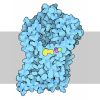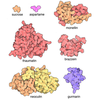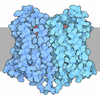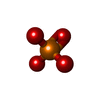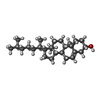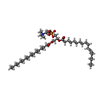[English] 日本語
 Yorodumi
Yorodumi- PDB-9dvl: Structure of the phosphate exporter XPR1/SLC53A1, InsP6-supplemented -
+ Open data
Open data
- Basic information
Basic information
| Entry | Database: PDB / ID: 9dvl | ||||||||||||||||||||||||
|---|---|---|---|---|---|---|---|---|---|---|---|---|---|---|---|---|---|---|---|---|---|---|---|---|---|
| Title | Structure of the phosphate exporter XPR1/SLC53A1, InsP6-supplemented | ||||||||||||||||||||||||
 Components Components | Solute carrier family 53 member 1 | ||||||||||||||||||||||||
 Keywords Keywords | TRANSPORT PROTEIN / Inorganic phosphate exporter | ||||||||||||||||||||||||
| Function / homology |  Function and homology information Function and homology informationphosphate transmembrane transporter activity / phosphate ion transport / intracellular phosphate ion homeostasis / phosphate ion transmembrane transport / cellular response to phosphate starvation / inositol hexakisphosphate binding / efflux transmembrane transporter activity / response to virus / virus receptor activity / plasma membrane Similarity search - Function | ||||||||||||||||||||||||
| Biological species |  Homo sapiens (human) Homo sapiens (human) | ||||||||||||||||||||||||
| Method | ELECTRON MICROSCOPY / single particle reconstruction / cryo EM / Resolution: 2.97 Å | ||||||||||||||||||||||||
 Authors Authors | Zhu, Q. / Diver, M.M. | ||||||||||||||||||||||||
| Funding support |  United States, 1items United States, 1items
| ||||||||||||||||||||||||
 Citation Citation |  Journal: Nat Commun / Year: 2025 Journal: Nat Commun / Year: 2025Title: Transport and InsP gating mechanisms of the human inorganic phosphate exporter XPR1. Authors: Qinyu Zhu / Madeleine F Yaggi / Nikolaus Jork / Henning J Jessen / Melinda M Diver /   Abstract: Inorganic phosphate (Pi) has essential metabolic and structural roles in living organisms. The Pi exporter, XPR1/SLC53A1, is critical for cellular Pi homeostasis. When intercellular Pi is high, cells ...Inorganic phosphate (Pi) has essential metabolic and structural roles in living organisms. The Pi exporter, XPR1/SLC53A1, is critical for cellular Pi homeostasis. When intercellular Pi is high, cells accumulate inositol pyrophosphate (1,5-InsP), a signaling molecule required for XPR1 function. Inactivating XPR1 mutations lead to brain calcifications, causing neurological symptoms including movement disorders, psychosis, and dementia. Here, cryo-electron microscopy structures of dimeric XPR1 and functional characterization delineate the substrate translocation pathway and how InsP initiates Pi transport. Binding of InsP to XPR1, but not the related inositol polyphosphate InsP, rigidifies the intracellular SPX domains, with InsP bridging the dimers and SPX and transmembrane domains. Locked in this state, the C-terminal tail is sequestered, revealing the entrance to the transport pathway, thus explaining the obligate roles of the SPX domain and InsP. Together, these findings advance our understanding of XPR1 transport activity and expand opportunities for rationalizing disease mechanisms and therapeutic intervention. | ||||||||||||||||||||||||
| History |
|
- Structure visualization
Structure visualization
| Structure viewer | Molecule:  Molmil Molmil Jmol/JSmol Jmol/JSmol |
|---|
- Downloads & links
Downloads & links
- Download
Download
| PDBx/mmCIF format |  9dvl.cif.gz 9dvl.cif.gz | 321.6 KB | Display |  PDBx/mmCIF format PDBx/mmCIF format |
|---|---|---|---|---|
| PDB format |  pdb9dvl.ent.gz pdb9dvl.ent.gz | 263.1 KB | Display |  PDB format PDB format |
| PDBx/mmJSON format |  9dvl.json.gz 9dvl.json.gz | Tree view |  PDBx/mmJSON format PDBx/mmJSON format | |
| Others |  Other downloads Other downloads |
-Validation report
| Summary document |  9dvl_validation.pdf.gz 9dvl_validation.pdf.gz | 1.4 MB | Display |  wwPDB validaton report wwPDB validaton report |
|---|---|---|---|---|
| Full document |  9dvl_full_validation.pdf.gz 9dvl_full_validation.pdf.gz | 1.4 MB | Display | |
| Data in XML |  9dvl_validation.xml.gz 9dvl_validation.xml.gz | 37.3 KB | Display | |
| Data in CIF |  9dvl_validation.cif.gz 9dvl_validation.cif.gz | 52 KB | Display | |
| Arichive directory |  https://data.pdbj.org/pub/pdb/validation_reports/dv/9dvl https://data.pdbj.org/pub/pdb/validation_reports/dv/9dvl ftp://data.pdbj.org/pub/pdb/validation_reports/dv/9dvl ftp://data.pdbj.org/pub/pdb/validation_reports/dv/9dvl | HTTPS FTP |
-Related structure data
| Related structure data |  47210MC  9dvjC  9dvkC  9dvmC  9dvnC  9dvoC 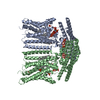 9dvpC M: map data used to model this data C: citing same article ( |
|---|---|
| Similar structure data | Similarity search - Function & homology  F&H Search F&H Search |
- Links
Links
- Assembly
Assembly
| Deposited unit | 
|
|---|---|
| 1 |
|
- Components
Components
| #1: Protein | Mass: 82364.734 Da / Num. of mol.: 2 Source method: isolated from a genetically manipulated source Source: (gene. exp.)  Homo sapiens (human) / Gene: XPR1, SLC53A1, SYG1, X3 / Production host: Homo sapiens (human) / Gene: XPR1, SLC53A1, SYG1, X3 / Production host:  Homo sapiens (human) / References: UniProt: Q9UBH6 Homo sapiens (human) / References: UniProt: Q9UBH6#2: Chemical | ChemComp-PO4 / #3: Chemical | #4: Chemical | Has ligand of interest | Y | Has protein modification | Y | |
|---|
-Experimental details
-Experiment
| Experiment | Method: ELECTRON MICROSCOPY |
|---|---|
| EM experiment | Aggregation state: PARTICLE / 3D reconstruction method: single particle reconstruction |
- Sample preparation
Sample preparation
| Component | Name: XPR1/SLC53A1 / Type: ORGANELLE OR CELLULAR COMPONENT / Entity ID: #1 / Source: RECOMBINANT |
|---|---|
| Source (natural) | Organism:  Homo sapiens (human) Homo sapiens (human) |
| Source (recombinant) | Organism:  Homo sapiens (human) Homo sapiens (human) |
| Buffer solution | pH: 7.4 |
| Specimen | Embedding applied: NO / Shadowing applied: NO / Staining applied: NO / Vitrification applied: YES |
| Vitrification | Cryogen name: ETHANE |
- Electron microscopy imaging
Electron microscopy imaging
| Experimental equipment |  Model: Titan Krios / Image courtesy: FEI Company |
|---|---|
| Microscopy | Model: TFS KRIOS |
| Electron gun | Electron source:  FIELD EMISSION GUN / Accelerating voltage: 300 kV / Illumination mode: FLOOD BEAM FIELD EMISSION GUN / Accelerating voltage: 300 kV / Illumination mode: FLOOD BEAM |
| Electron lens | Mode: BRIGHT FIELD / Nominal defocus max: 1700 nm / Nominal defocus min: 700 nm |
| Image recording | Electron dose: 66 e/Å2 / Film or detector model: GATAN K3 (6k x 4k) |
- Processing
Processing
| EM software | Name: PHENIX / Category: model refinement | ||||||||||||||||||||||||
|---|---|---|---|---|---|---|---|---|---|---|---|---|---|---|---|---|---|---|---|---|---|---|---|---|---|
| CTF correction | Type: PHASE FLIPPING AND AMPLITUDE CORRECTION | ||||||||||||||||||||||||
| 3D reconstruction | Resolution: 2.97 Å / Resolution method: FSC 0.143 CUT-OFF / Num. of particles: 487706 / Symmetry type: POINT | ||||||||||||||||||||||||
| Refinement | Highest resolution: 2.97 Å Stereochemistry target values: REAL-SPACE (WEIGHTED MAP SUM AT ATOM CENTERS) | ||||||||||||||||||||||||
| Refine LS restraints |
|
 Movie
Movie Controller
Controller









 PDBj
PDBj


